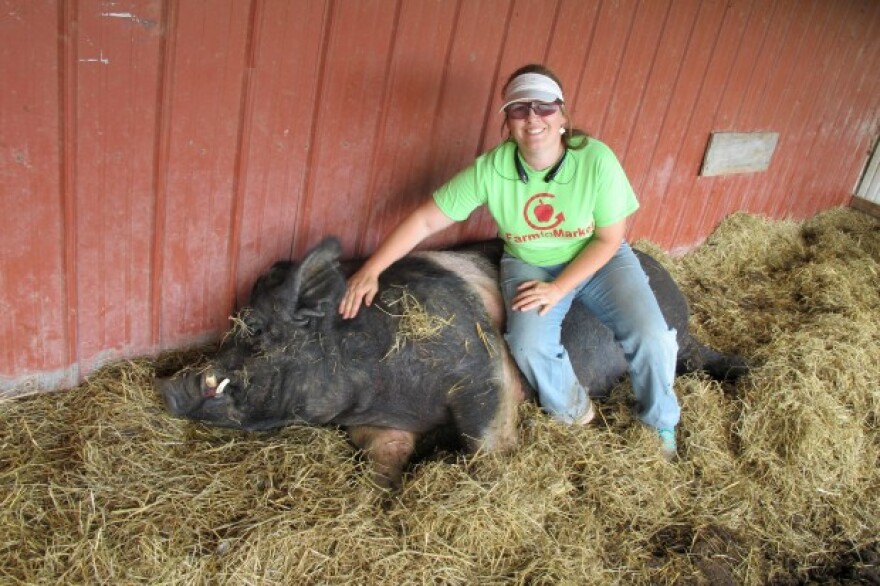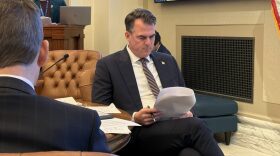There’s a $1 billion hole in the state budget that has consequences for Oklahoma’s environment and natural resources. A controversial state question could pit farmer against farmer. The ground beneath Oklahoma is shaking — figuratively and literally in 2016 — and StateImpact is on it.
Not If, But When: Preparing For The Next Drought
When 2015 started, Oklahoma was so deep in drought lakes were drying up and cities in the southwest part of the state were panicked about where their water would come from if the drought continued.
But State Climatologist Gary McManus said the state avoided catastrophe.
“Right about April 12 it started to rain again, and of course it didn’t stop raining for three months,” State Climatologist Gary McManus told a group of wheat farmers in El Reno in August.
The drought is over. Oklahoma got lucky with of one of the strongest El Niños ever, but it’s about to be over as well, and no one knows what’s coming this summer.
What water planners do know is the best time to prepare for drought is during wet times, but J.D. Strong at the Oklahoma Water Resources Board also says rain usually equals apathy.
“What we hope won’t happen is what’s often happened in the past, which is once the rains come and the drought begins to subside, most people tend to settle back into this apathetic tendency to just waste water,” Strong told StateImpact in May.
It does appear Oklahoma learned a lesson with this latest drought. Projects are continuing and long-term solutions are getting serious discussion. It’s something we’ll keep covering.
Earthquakes Get Serious, Politicians Follow Suit
StateImpact has been reporting on the science linking Oklahoma’s earthquake boom to the oil and gas industry for years, and a lot has changed in that time. At first, state officials didn’t want to recognize the link. Now they do. More and more, state regulators are cracking down on wells they think could be contributing to the shaking.

Concern about the quakes is growing from regular folks and public safety officials. The political reaction to the earthquakes is growing, too. Lawmakers at the state Capitol have been holding hearings to ask regulators if voluntary restrictions are enough.
The U.S. Department of Homeland Security has expressed concerns about the safety of the massive oil hub in Cushing, Okla, in earthquake country.
At a state Capitol hearing in October, Democratic State Reps. Richard Morrissette and Cory Williams asked Tim Baker with the Oklahoma Corporation Commission if voluntary restriction are enough.
“First thing I make crystal clear is: this is a Voluntary effort, but if they tell me to go fly a kite then the next thing I’m going to do is file an application to amend, modify or vacate the order. And everyone has ultimately complied up to this point,” Baker said.

That might not be the case anymore, 2016 could be a year where the science of oil industry-linked earthquakes is tested in court. Oklahoma City oil company SandRidge Energy is defying regulators’ requests to shut down six wells near the Kansas border.
There are two earthquake related lawsuits making their way through state courts, and the Sierra Club has taken first steps toward suing energy companies over disposal wells they say are violating federal pollution laws.
Fighting The Feds And Going Broke
2016 is a big election year too, and in the state legislature. StateImpact will report on bills written to address energy, environment and natural resource issues, as well as on campaigns and political issues that could affect Oklahoma — including how the next president will handle federal energy and environmental policy.
When Oklahomans go to vote in November, there will be State Question 777 — the Right-to-Farm. Right-to-Farm pits agriculture against environmentalists and animal rights groups, and is more complicated than the ballot would indicate.
So far, farmers we talked to, like Coleen Thornton, are still trying to figure it out.
“I’m not sure we need an amendment to our constitution, but I do understand the question of: Do we want someone from out of state telling us how we do business?” Coleen Thornton said from her farm near Tahlequah, Okla.

The Right-to-Farm issue has evolved from a local fight to one against potential federal overreach. And when it comes to fighting the federal government Oklahoma often leads the way. In D.C., Republican U.S. Senator Jim Inhofe is using his bully pulpit to fight the EPA.
One of his hated environmental regulations is the expansion of the Waters of the United States rule.
“That would be an absolute disaster for our farmers and our ranchers,” Inhofe told StateImpact in December.
Some rules have impacted utilities in Oklahoma like Oklahoma Gas and Electric, which is still trying to figure out how to pay for expensive upgrades to its coal-fired power plants. OG&E has a big rate case coming up. We’ll report on that and also how Oklahoma’s big electric utilities plan to deal with customer-generated solar energy.

But we being with one issue that will cast a long shadow over StateImpact’s coverage in 2016. The state budget is in crisis and threatening functions and services that could affect Oklahoma’s water, air, land and infrastructure.
StateImpact Oklahoma is a partnership among Oklahoma’s public radio stations and relies on contributions from readers and listeners to fulfill its mission of public service to Oklahoma and beyond. Donate online.









